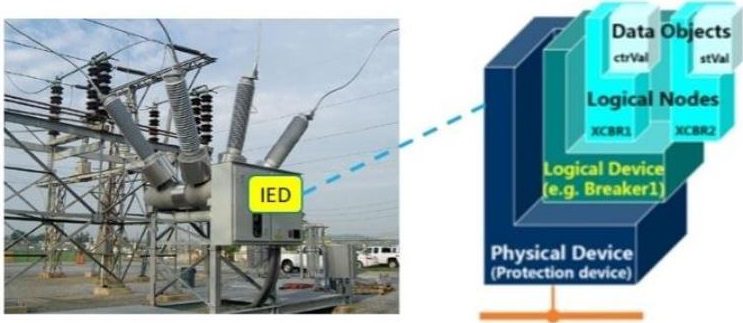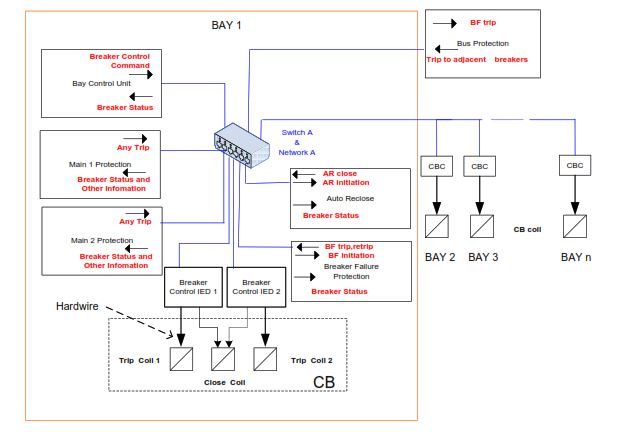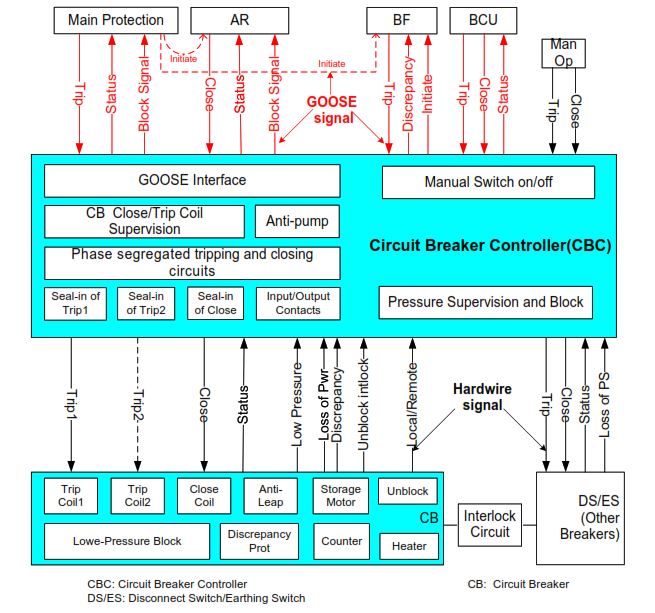
Photo from the article: designing a new smart IED for detecting and clearing faults in solar networks by Mahsa Shahrjerdi, Navid Ghaffarzadeh
Summery about Hv circuit breaker control intelligent electronic devices (IED):
With intelligent electronic devices (IED), it’s possible to extend new controls and automation deep into the substation’s process layer, thus allowing for real-time monitoring and management from a centralized remote-control hub.
A circuit breaker control IED can be installed either in the circuit breaker cabinet in the switchyard or within the relay/control room. we consider that the BF, AR, and CS functions are not integrated into the Breaker Control IED.
In some substation applications, instead of having a separate trip/close wire connected to the same Circuit Breaker for each individual protective or control IED, a circuit breaker control IED can be used to combine all trip or close signals from all the IEDs that need to operate the high voltage circuit breaker.
In addition, the circuit breaker Control IED monitors any change of the CB status (e.g. position
status, pressure, etc.) via auxiliary contacts and provides them to related IEDs. It will also provide some auxiliary functions such as breaker status supervision and an anti-pump circuit.
The main functions of a circuit breaker Control IED:
a) Acquisition of primary switch status information.
b) Execution of Trip/Close command of the primary switches either locally or remotely (SCADA, Bay Control Unit, protection IEDs, etc.)
c) Phase segregated tripping and closing circuit (no integrated logic such as pole discrepancy).
d) Anti-pumping function which prevents the reclosing of the circuit breaker until the cause of the failure to close has been corrected. If an anti-pump function exists in the circuit breaker itself, the anti-pump function of Breaker Control IED should be put out of service.
e) Circuit Breaker Close and Trip Coil Supervision.
f) Pressure supervision. The Breaker Control IED supervises all kinds of pressure signals to alert and block tripping/closing commands depending on the pressure level.
For high voltage circuit breaker signal in substation please read this post.
Signal interaction in circuit breaker IED:
When a power system fault occurs, protection IEDs will detect the fault and issue a trip command to the Breaker Control IED. The Breaker Control IED trips the corresponding circuit breakers using hardwires (tripping Phase A, B, C, or 3 phase tripping). After the tripping, the circuit breaker control IED will acquire the new circuit breaker Status position (52a / 52b status) which will also be provided to the relevant IEDs using hardwired signals.
Additionally, other status information might be available such as Low Pressure, etc.
The trip signal of the protection IEDs is also hardwired to initiate the external AR(Auto recloser) function. The AR Close Command is hardwired to the Breaker Control IED to execute the reclosing. In addition, the trip signal of the protection IEDs are also hardwired to initiate the external BF function. Re-trip signals are also hardwired to the Breaker Control IED.
The remote Control Command signal (Opening/Closing) from either RTU/SCADA or local Substation Automation Systems or Bay Control Unit is also hardwired to the circuit breaker Control IED.
Circuit breaker IED with IEC goose message and IEC 61850:
Figure 1 shows a typical application of a circuit breaker control IED based on GOOSE communication (to simplify the figure, only network A is shown while in real projects, a redundant separated Network B may also be available for higher reliability consideration).
For more information about high voltage circuit breaker control And interlocking in IEC 61850 protocol please read this article.
In a substation, the Breaker Control IED is located between the secondary devices and the high voltage primary equipment, functioning as a digital interface of the un-digitalized breakers.

Figure 1: High voltage circuit breaker controller IED with IEC 61850 diagram
At the process bus level, high voltage circuit breaker Control IED can communicate with upper-level intelligent IEDs such as protection devices, Auto Reclosure (AR), and Bay Control Unit (BCU).
For the GOOSE communication, the circuit breaker control IED can work as a subscriber and a publisher at the same time, so it can receive and send GOOSE messages simultaneously.
As a publisher, the Breaker Control IED continuously publishes the status information gathered from the breakers to all other IEDs on the process bus, so all the subscriber IEDs (including protection devices, AR and BCU) can receive these messages and thus get the real-time information of breaker position status and some other information, this information is useful to these bay level IEDs and can be applied into all kinds of function logic processing.
As a subscriber, the circuit breaker control IED receives GOOSE control commands from all the related publishers (such as protection devices, AR, BF, and BCU).
In this figure the abbreviations are as follows:
CB: Circuit Breaker, AR: Auto Reclosure,
DS/ES: Disconnect Switch/Earthing Switch, BF: Circuit Breaker Failure protection, BCU: Bay Control Unit
Other Main functions of circuit breaker control IED:
In-circuit breaker Control IED should not only provide the functions of GOOSE message sending/receiving processing and tripping/closing the breakers but also provide some auxiliary functions such as breaker status supervision and anti-pump circuit.
In figure 2 show circuit breaker control IED functional and signal interactions:

Figure 2: circuit breaker control IED functional and signal interactions
- Gather information from breakers as well as send control commands to them. The Circuit Breaker Controller contains lots of hardwiring input/output contacts which enable it to communicate with the traditional analog signal-based breakers. These contacts permit the Circuit Breaker Controller to gather breakers’ position status, control pressure status, and some other information from the bay breakers and also permit circuit breaker control IED to send trip or close control commands to these breakers.
- Send breakers information to the bay level device via GOOSE message. After the Breaker Control IED gathers the electrical information from the bay breakers, it will convert these electrical analog signals into digital signals and publish them at the bay level IEDs via the process bus.
- Receive GOOSE message from bay level device and operate the breakers. When a power system fault occurs or remote control command is issued, the related protective device or bay control unit will publish the corresponding GOOSE message (i.e. trip command, close command) immediately. As one of the subscribers, the Breaker Control IED is able to receive these GOOSE messages and take the right actions to trip or close the related breaker via hardwire output contacts.
- Phase segregated tripping and closing circuits. The circuit breaker control IED may comprise phase segregated tripping circuits and phase segregated closing circuits. Usually, the Breaker Control IED should provide a control circuit for a three-phase circuit breaker with one close coil and two trip coils.
- Repeated tripping prevention circuit (Anti-pump). If the breaker is manually closed or automatically re-closed on a permanent fault and the closing signal lasts for a relatively long time, the breaker may be closed many times after tripping. Repeated tripping prevention circuits (Anti-pump function) should be provided in Breaker Control IED to prevent such repeated tripping, thus the circuit breaker will trip only once as expected by preventing further closing until the closing circuit has been de-energized by the operator’s releasing the control switch. If there is also an anti-pump circuit in the circuit breaker itself, the anti-pump function in the circuit breaker Control IED should be released by configuration.
- Circuit Breaker Close Coil Supervision. The Breaker Control IED sometimes should also provide the function support for circuit breaker close or trip state supervision. The close state supervision can be achieved by auxiliary relays in the device while the corresponding terminal is connected to the negative pole of the power supply in series with normal closed auxiliary contact (52b) of the circuit breaker. In addition, if this terminal is connected with normal closed auxiliary contact (52b) of the circuit breaker and its close coil (CC), these auxiliary relays can provide supervision on the close coil as well.
- Circuit Breaker Trip Coil Supervision. Several auxiliary relays in the relay can also be applied to supervise the open state of the circuit breaker while the corresponding terminal is connected to the negative pole of the power supply in series with normal open auxiliary contact (52a) of the circuit breaker. In addition, if this terminal is connected to normal open auxiliary contact of circuit breaker (52a) and its trip coil (TC), the related auxiliary relays can provide supervision on the trip coil as well.
- Pressure Supervision and Block. The pressure in breakers is critical for circuit breaker operation, and mal-operation to these breakers in abnormal pressure will decrease the lifetime of the breakers and even damage them. So the circuit breaker control IED should supervise all kinds of pressure signals in the related circuit breaker and implement corresponding pressure block when trip or close command comes. These block functions are:
* Operation (trip & close) blocked by abnormal pressure
* Re-closing blocked by low pressure
* Closing blocked by low pressure
* Tripping blocked by low pressure
- Manual Switch on/off. Besides providing the function for protection device tripping and auto-reclosing, the circuit breaker Control IED should also provide a manual switch on/off in the device for the convenient operation to the circuit breakers.



